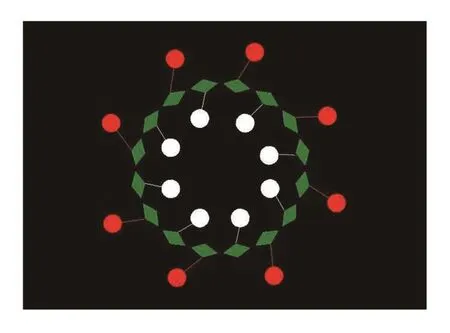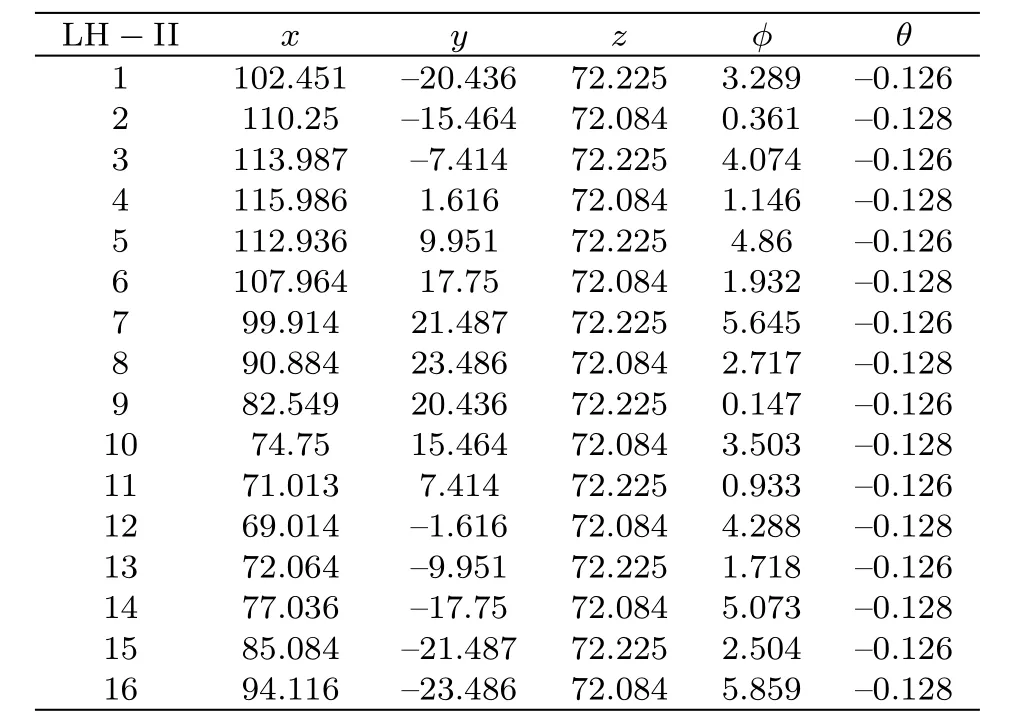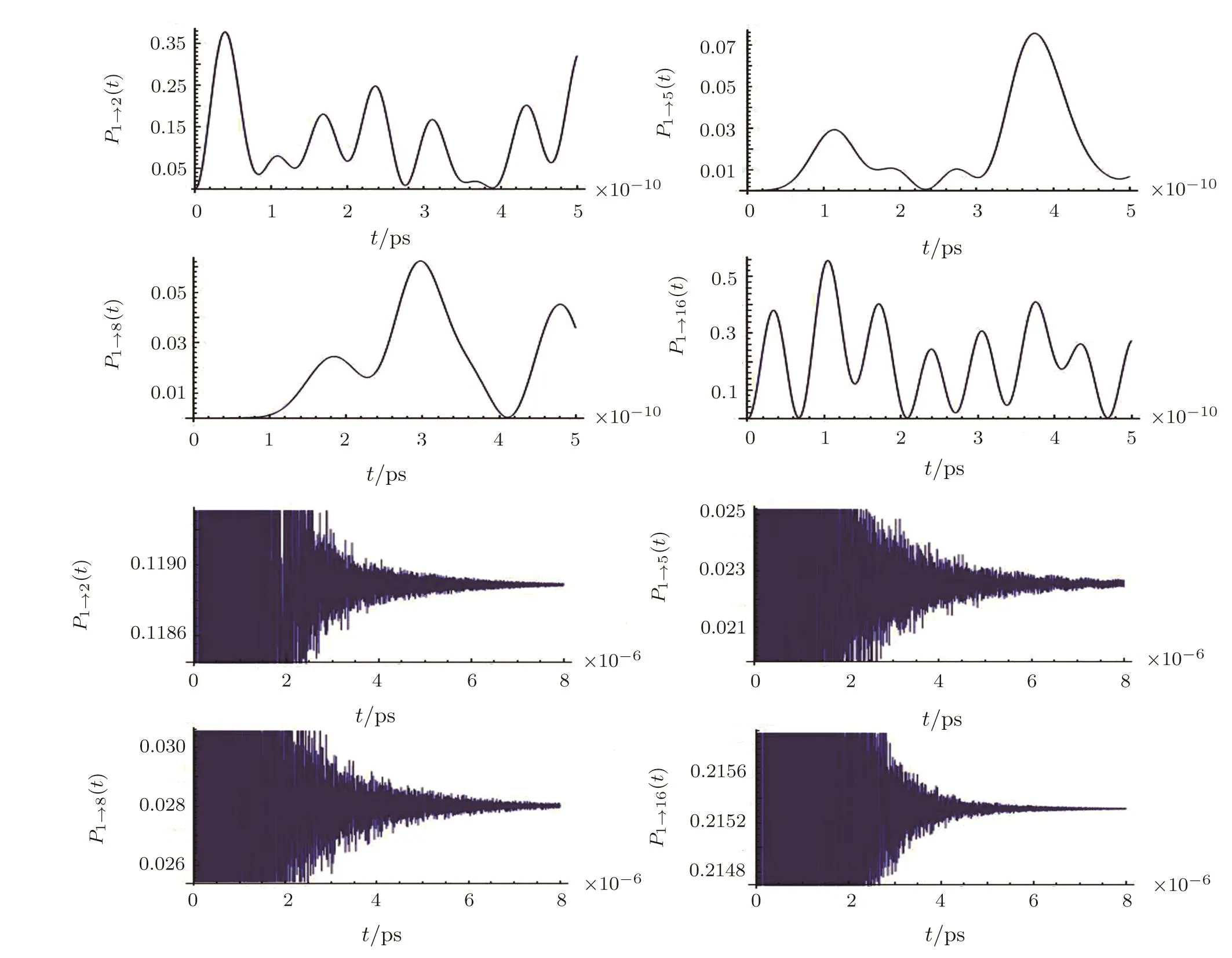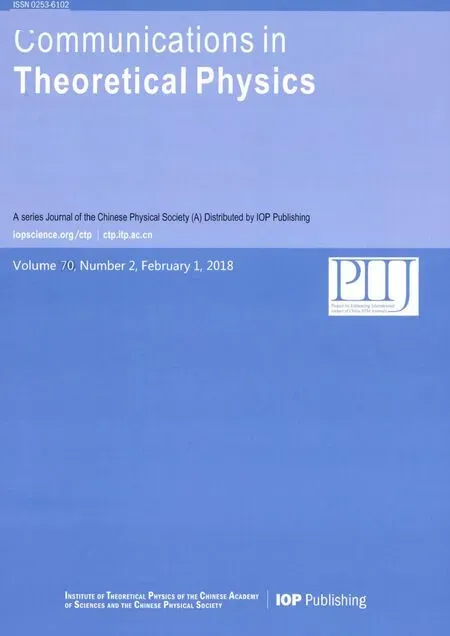Energy Transfer in the Light-Harvesting Complexes of Purple Bacteria∗
2018-08-02BeiBeiHe何贝贝MengMengMing明蒙蒙ChangYongLiu刘昌勇GuoDongWang王国栋LiQin覃莉andYouWeiLi李有为
Bei-Bei He(何贝贝),Meng-Meng Ming(明蒙蒙), Chang-Yong Liu(刘昌勇),Guo-Dong Wang(王国栋),Li Qin(覃莉),and You-Wei Li(李有为)
College of Science,Northwest A&F University,Yangling 712100,China
AbstractIn this paper,we use a nonlinear decohering quantum model to study the initial step of photosynthesis which is an ultrafast transfer process of absorption the sunlight by light-harvesting complexes and electronic excitation transfer to the reaction center(RC).In this decohering model,the Hamiltonian of the system commutes with the systemenvironment interaction.We take B850 ring of light-harvesting complex II(LH-II)in purple bacteria as an example to calculate the efficiency of the energy transfer as a function of time.We find that the environmental noise can make the LH-II have stable energy transfer efficiency over a long time.This is to say that the environmental noise which is the decohering source has advantage of the energy transfer in the process of photosynthesis.
Key words:photosynthesis,light-harvesting complexes,energy transfer efficiency
1 Introduction
Photosynthesis is a process used by plants and other organisms to convert light energy into stable chemical energy that can later be released to fuel the organisms’activities.[1]Although photosynthesis is performed differently by different species,photosynthesis is very important for the earth life.Thus it is interesting to explore the nature of the energy transfer.[2]In recent years,more and more scientists have put a lot of attention on the experimental work[3]and theoretical studies[4−9]about the process of highly efficient energy transfer from light-harvesting to reaction center.As it is known,excitation energy transfer is the key process in photosynthesis and it is not only a classical hopping mechanism but also maybe a quantum mechanical.[10]An experiment on reaction center by R.Fleming get a direct evidence that exciton coherence enable highly efficient energy transfer in photosynthesis.[11]Now,there are many experiments making use of the ultrafast laser technology verified the time scale of the exciton energy transfer and proved that quantum superposition and quantum coherence play an important role in exciton energy transfer.[11−14]Basing on the predecessors’work,we can stimulate the exciton energy transfer with a model to clear out the further mechanism of efficient energy transfer.Some data show quantum coherence in the photosynthesis has a certain effect on energy transfer.They assist the exciton energy transfer in different ways[15−20]For instance,Panitchayangkoon certified in photosynthetic light-harvesting complexes have a straightforward quantum transport through experiment.[19]Engel et al.also found evidence of quantum coherence at 77 K in many pigment molecules and even in the reaction center.[11,15−16]The interaction between the quantum system and the fluctuating environment can significantly affect the dynamics of the quantum system.Decoherence plays a fundamental role in transforming from the quantum to the classical regime.[21]In general,the overall effect of environmental and static disturbances is not conducive to quantum transport,however,in the previous papers,it is proved that the environment contributes to quantum transport.In this paper,we use a nonlinear decohering quantum model to study the energy transfer efficiency of photosynthesis.We take the system of B850 in LH-II of purple bacteria for an example to illustrate the effect of the environmental noise,which is the decohering source.
2 System Interaction with Environment
We take the initial step of photosynthesis,which is an ultrafast transfer process as a decohering quantum process,so that we will discuss a nonlinear decohering quantum model that can be used to describe the exciton energy transfer of photosynthesis.The photosynthesis system,which is considered as N coupled two-level systems interact with environment.The Hamiltonian for the combined system and environment is given by




where ckis the system-environment coupling.There is no energy transfer between the system and environment,so that this is decohering effect.The last term

is a renormalization term.[22]
The model is an exactly soluble.The total Hamiltonian(1)can be solved by the unitary transformation[23−24]

After the unitary transformation,the Hamiltonian of Eq.(1)has the decoupled formFollowing the same way as Refs.[23–24]the total density operator with original Hamiltonian(1)can be written as


is written in the matrix element representation under dressed states|φ(n,i)⟩as

where the i is the number of quanta of excitation of the harmonic oscillator of environment with i=0,1,...∞.The m denotes the eigenstate of Hamiltonian of the systemThe phasecan be written as follow



The Q1(t)and Q2(t)are the quantity associated with thermal bath

The spectrum of the bath J(ω)is

For an Ohmic bath,we take[25]

where the η is reorganization energy and ωcis cut-o fffrequency.The Q1(t)and Q2(t)can be integrated out in Ohmic bath as follows[26]

In the next section,we use this nonlinear decohering model to calculate the energy transfer efficiency of B850 ring of light-harvesting complex II(LH-II)in purple bacteria.
3 Exciton Energy Transfer Efficiency of B850 Ring in Light-Harvesting Complex II
In this section,we will explore the effect of quantum decoherence on energy transfer by calculating exciton energy transfer for LH-II in purple bacteria as shown in Fig.1.We take the B850 ring of LH-II as a simple photosynthetic system and the pigments and protein as a heat bath.[27−28]The LH-II are intracytoplasmic transmembrane pigment-proteins that form ring-like structures,oligomers of αβ-heterodimers in purple bacteria.[29]The peripheral LH-II absorb maxima at shorter wavelengths than light-harvesting complexes I(LH-I).Energy is transferred efficiently by vibration from LH-II→ LH-II→LH-I→photosynthetic reaction center(RC).[4]

Fig.1 (Color online)Seeing B850 BChl-a molecules from the top.The white and red representative α and β-apoproteins,which B850(green)across.[29]
The B850 system of LH-II has 16 Bacteriochlorophylls(BChls)in the aggregate. Every single BChl can be viewed as a two-level quantum system.We denote theandrepresent the excited state(Qyexcitations)and ground state of the i-th BChl respectively.In oder to obtain an effective Hamiltonian for B850 system,we assume the electronic excitations of the aggregate can be described in terms of single BChl Qyexcitations[4]


We denote non-adjacent dipole-dipole interactions by ξi,jrepresents. The leading term interaction between the BChls is due to induced dipole-induced dipole coupling


The Hamiltonian can be written out using the data(Table 1).

Table 1 The x,y,z represent the coordinate data of LH-II.The ϕ is the azimuthal angle of the dipole moment unit vectors and θ is the angle corresponding to the z axis.These data can be used to effective Hamiltonian calculation.[4]
We take 1st BChl as excited state and other 15 BChls on ground states at initial time for an example to explore the energy transfer efficiency.That is

The energy transfer efficiency from 1st BChl to i-th BChl can be de fined as

where the pi(t)is the probability of i-th BChl at excited state that is

Basing on our assumption,we know that p1(0)=1 and pi(0)=0,forThen the energy transfer efficiency from 1st BChl to i-th BChl becomes

This is to say the density matrix diagonal element represents the efficiency of the energy transfer.We take the cut-offωc=150 cm−1,[27]the reorganization energy η=35 cm−1[31]and the temperature T=300 K.By using the mathematica,we obtained the transfer efficiency changes with time under the influence of the environment(Fig.2).We calculateand P1→16to demonstrate the property of quantum transfer efficiency.In order to more intuitively compare the effect of the environment on the quantum transfer efficiency,we also calculated the quantum transition efficiency without environmental effect(Fig.3).
From Figs.2 and 3,we have obtained energy transfer efficiency in the B850 ring of LH-II changing with the time in the presence or absence of the environment influence.From Fig.2,we find that P1→2and P1→16are larger than the P1→5and P1→8.This is because the 1st BChl couples strongly to 2nd BChl and 16-th BChl.Comparing the(Fig.3),we obtain that the environmental noise can promote the vibration frequency of the efficiency and make the LH-II have stable energy transfer efficiency over a long time.This is to say that the environmental noise,which is the decohering source has advantage of the energy transfer in the process of photosynthesis.

Fig.2 In the presence of environmental influence,energy transfer efficiency as a function of time.These figures are derived from the data in Table 1.We take the cut-offωc=150 cm−1,the reorganization energy η =35 cm−1 and the temperature T=300 K.The four figures on the up are the short time behavior and the four figures on the down are the long time behavior.We see that the energy transfer efficiency have stable value over a long time.

Fig.3 In the absence of environmental influence,the energy transfer efficiency as a function of time.We see that the energy transfer efficiency have not stable energy transfer efficiency over a long time.
4 Conclusion
In this paper,we have explored the physical mechanism of initial process of photosynthesis in purple bacteria that the effect of quantum decoherence on exciton transfer efficiency.The energy transfer efficiency of 16 bodies in B850 ring of Light–harvesting Complex II in the process of photosynthesis was studied.Our calculation results show that the environmental noise,which is the decohering source in quantum photosynthesis process can make the LH-II have stable energy transfer efficiency over a long time.In the process of photosynthesis,photosynthetic pigment molecules absorb sunlight and transfer the exciton energy to the reaction center.This is a very complex physical process,so that the physical mechanism and effective energy transfer are difficult to study.We only consider a simplest nonlinear decohering quantum model to show that the noise have advantage of the energy transfer in this process.There are much work needed to do in order to obtain the physical mechanism of photosynthesis in the future.
猜你喜欢
杂志排行
Communications in Theoretical Physics的其它文章
- A Numerical Investigation of Nanocomposite of Copper and Titanium Dioxide in Water Based Fluid Influenced by Instigated Magnetic Region
- Effects of Thermal Radiation on a 3D Sisko Fluid over a Porous Medium Using Cattaneo-Christov Heat Flux Model∗
- Effect of Critical Beam Radius on Self-focusing of cosh-Gaussian Laser Beams in Collisionless Magnetized Plasma
- Phase Sensitive Photonic Flash∗
- Jeans Instability of Self Gravitating Dust Cloud in Presence of Effective Electrostatic Pressure
- Self-Similar Solution of Spherical Shock Wave Propagation in a Mixture of a Gas and Small Solid Particles with Increasing Energy under the Influence of Gravitational Field and Monochromatic Radiation
